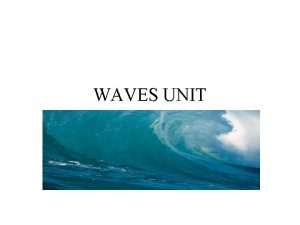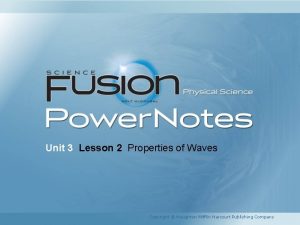Unit 1 Lesson 2 Properties of Waves Copyright












- Slides: 12

Unit 1 Lesson 2 Properties of Waves Copyright © Houghton Mifflin Harcourt Publishing Company

Unit 1 Lesson 2 Properties of Waves Amp It Up! How can we describe a wave? • A wave is disturbance that transfers energy from one place to another. • A wave’s amplitude is a measure of how far the particles in the medium move away from their normal rest position. • The wavelength is the distance from any point on a wave to an identical point on the next wave. This measures the length of one cycle, or repetition. Copyright © Houghton Mifflin Harcourt Publishing Company

Unit 1 Lesson 2 Properties of Waves How can we describe a wave? • What is the wavelength of this wave? What is the wave’s amplitude? Copyright © Houghton Mifflin Harcourt Publishing Company

Unit 1 Lesson 2 Properties of Waves How can we describe a wave? • Another property is wave period, the time required for one wavelength to pass a given point. • Another way to express the time of a wave’s cycle is frequency. The frequency of a wave tells how many cycles occur in an amount of time, usually 1 s. Copyright © Houghton Mifflin Harcourt Publishing Company

Unit 1 Lesson 2 Properties of Waves How can we describe a wave? • Frequency is measured in hertz (Hz). One hertz equals one wavelength per second. • Frequency is the inverse of period. Copyright © Houghton Mifflin Harcourt Publishing Company

Unit 1 Lesson 2 Properties of Waves Amp It Down What affects the energy of a wave? • Some waves carry more energy than others. • For a mechanical wave, amplitude is related to the amount of energy the wave carries. For two similar waves, the wave with greater amplitude carries more energy. • Greater frequency can also mean greater energy in a given amount of time. For most electromagnetic (EM) waves, energy is most strongly related to frequency. Copyright © Houghton Mifflin Harcourt Publishing Company

Unit 1 Lesson 2 Properties of Waves What affects the energy of a wave? • As a wave moves through a medium, particles may move in different directions or come to rest in different places. • As the wave travels through more of the medium, more energy is lost to the medium. • Often, higher-frequency waves lose energy more readily than lower-frequency waves lose energy. For example, when you stand far from a concert, you might hear only the low-frequency (bass) sounds. Copyright © Houghton Mifflin Harcourt Publishing Company

Unit 1 Lesson 2 Properties of Waves What affects the energy of a wave? • Many waves spread out in circles or spheres, called wavefronts. • As the circle expands, there is less energy available on the wavefront. Copyright © Houghton Mifflin Harcourt Publishing Company

Unit 1 Lesson 2 Properties of Waves A Happy Medium What determines the speed of a wave? • Wave speed, or the speed at which waves travel, depends on the properties of the medium. • Waves tend to travel more slowly in a denser medium. Copyright © Houghton Mifflin Harcourt Publishing Company

Unit 1 Lesson 2 Properties of Waves What determines the speed of a wave? • In gases, wave speed is higher at higher temperatures. • All electromagnetic waves travel at the same speed in empty space, but they travel more slowly through a denser medium. Copyright © Houghton Mifflin Harcourt Publishing Company

Unit 1 Lesson 2 Properties of Waves What determines the speed of a wave? • Wave speed can be calculated from frequency and wavelength. • Speed is distance divided by time. Copyright © Houghton Mifflin Harcourt Publishing Company

Unit 1 Lesson 2 Properties of Waves What determines the speed of a wave? • The speed of a wave equals its wavelength divided by its period. • This relationship can be combined with the relationship between wavelength and frequency. • Wavelength is equal to wave speed divided by frequency. Copyright © Houghton Mifflin Harcourt Publishing Company
 Parts of a longitudinal wave
Parts of a longitudinal wave Light is an electromagnetic wave true or false
Light is an electromagnetic wave true or false Example mechanical waves
Example mechanical waves Similarities of mechanical waves and electromagnetic waves
Similarities of mechanical waves and electromagnetic waves What type of waves are sound waves? *
What type of waves are sound waves? * Is echolocation transverse or longitudinal
Is echolocation transverse or longitudinal Short wave vs long wave radiation
Short wave vs long wave radiation Difference between matter waves and electromagnetic waves
Difference between matter waves and electromagnetic waves Mechanical vs electromagnetic waves
Mechanical vs electromagnetic waves Mechanical and electromagnetic waves similarities
Mechanical and electromagnetic waves similarities Seismic waves
Seismic waves Seismic waves are mechanical waves
Seismic waves are mechanical waves Compare and contrast p waves and s waves using venn diagram
Compare and contrast p waves and s waves using venn diagram























